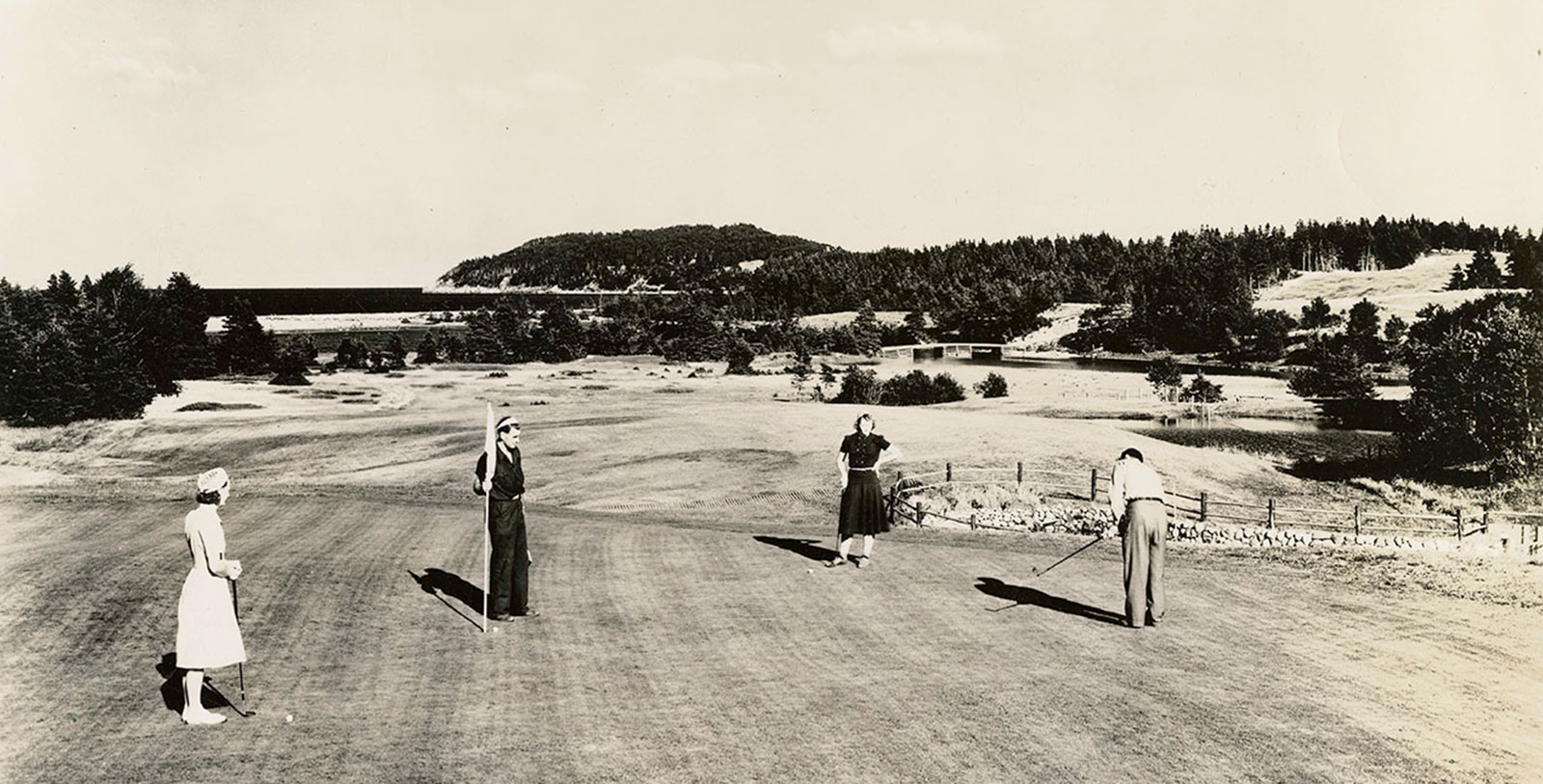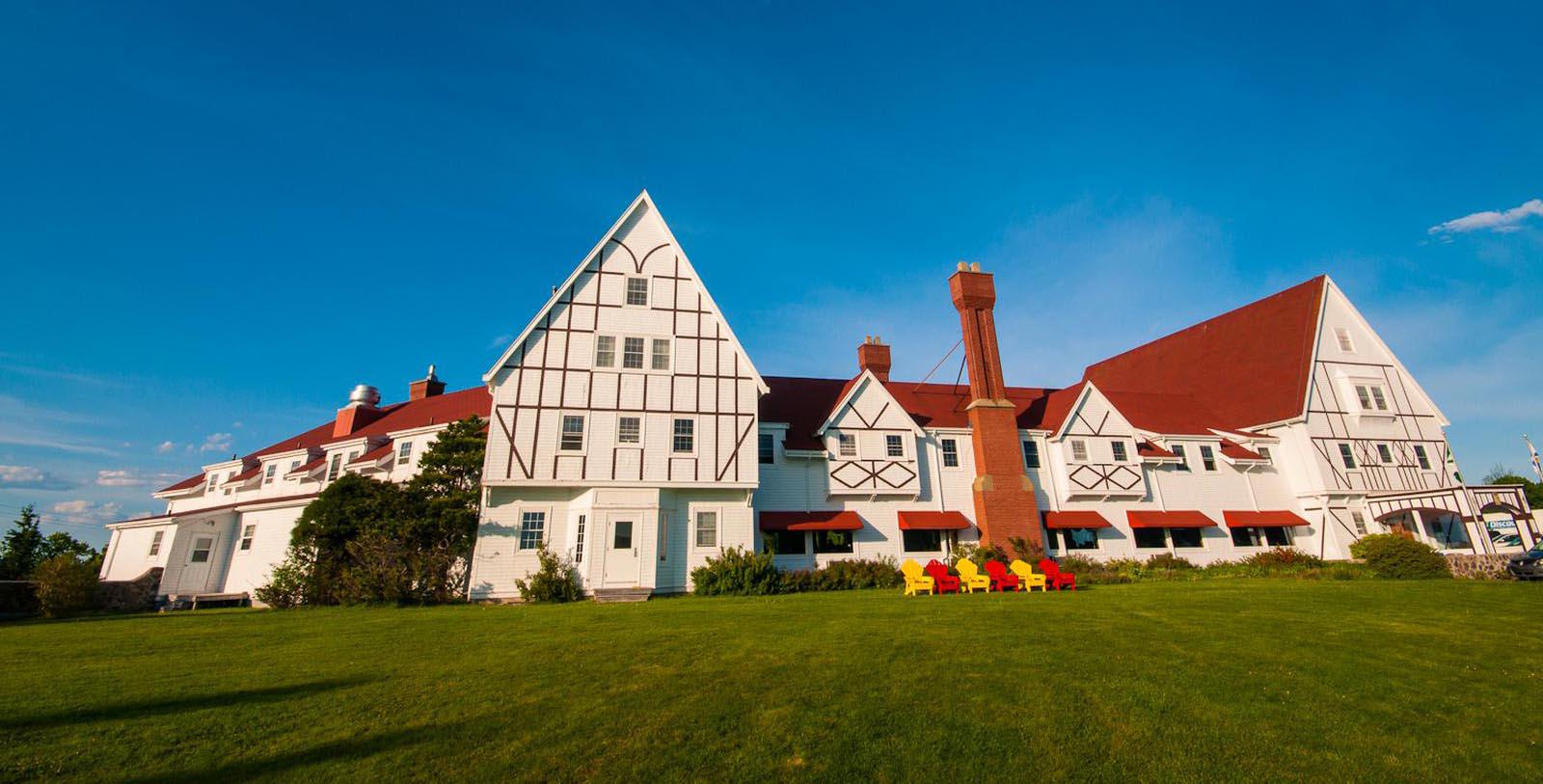Receive for Free - Discover & Explore eNewsletter monthly with advance notice of special offers, packages, and insider savings from 10% - 30% off Best Available Rates at selected hotels.
golf
Discover the Cape Breton Highland Links, which was originally designed by the great golf course architect Stanley Thompson.
While the Nova Scotian government was busy working on the future Keltic Lodge Resort and Spa, Parks Canada sought to further enhance travel to the Cape Breton Highlands. It specifically wished to attract tourists to the newly created Cape Breton Highlands National Park, then the only national park active in Atlantic Canada. To that end, the organization hired a renowned Canadian architect named Stanley Thompson to construct a brilliant nine-hole golf course next to the nascent resort. Excited, Thompson eagerly took the assignment and started work in 1939. The project proved to be a massive undertaking, namely due to the relative remoteness of Cape Breton Island itself. Thompson encountered significant difficulty moving machinery to the location, prompting his team to build the golf course by hand. He also had to adapt his plans half-way through the project upon realizing that a better route was needed to navigate a local branch of the Clyburn River. In fact, he even enlarged the design by an additional nine holes! Nevertheless, Thompson managed to create a brilliant golf course that wonderfully complemented the verdant landscape of the surrounding Cape Breton Highlands. He had specifically borrowed concepts from numerous Scottish golf courses to carve out each hole, with the Old Course in St Andrews providing the most inspiration. Thompson himself was incredibly proud of his work, often telling contemporaries that his “mountains and ocean course” was among the best he had ever created.
Now known as the “Cape Breton Highlands Links,” many avid golfers have agreed with Thompson’s assessment since the course’s debut during World War II. In fact, Sports Illustrated even identified the destination as his finest after conferring with a group of respected golf historians in 2002. Guests of the Keltic Lodge Resort and Spa can enjoy this heritage for themselves, too, as the golf course acts as an affiliate of the resort. Indeed, the holes still have their unique Scottish placenames—such as “Heich O’ Fash” and “Killiecrankie”—that Thompson assigned nearly a century ago. But visitors will also feel Thompson’s legacy in the layout of the holes themselves, as they all possess his original designs. Blind tees, rolling fairways, and undulating greens continue to be the hallmarks of the course, offering the same challenging experience that has entertained golfers for generations. Perhaps the greatest example of Thompson’s enduring design aesthetics is the fifth hole, otherwise known as the “Cappy Slap.” Replete with difficult tee shots and forced carries, the site closely resembles the famous “Eden” hole at St Andrew’s Old Course—one of Thompson’s favorites. Few places can truly offer such a rewarding game of golf today as the renowned Cape Breton Highlands Links. (Guests staying at the resort also have access to a luxurious pro shop, as well as numerous practice facilities and an on-site restaurant called “Stanley’s Sunset Grill.)
-
About the Location +
Located within the Canadian province of Nova Scotia, Cape Breton Island is one of the most fascinating places in Atlantic Canada. Its history harkens back millennia, with the first known inhabitants—the native Mi’kmaq and their ancestors—living on the island for generations. Hunter-gatherers who relied heavily upon the sea, they were eventually visited by European explorers beginning in the late 15th century. Italian mariner John Cabot was arguably the first to arrive at Cape Breton Island in 1497, although some historical evidence suggests that he may have visited Newfoundland further north. Nevertheless, the French eventually claimed Unama'ki—as the island was then known—and made it a part of its nascent North American empire during the 17th century. Over time, the region became an integral part of a colony known as “Acadia,” which covered a geographical region that extended all the way south to the present-day U.S. state of Maine. Cape Breton Island remained under French control well into the 18th century, even as the rest of Acadia was absorbed into the British Empire after the War of Spanish Succession. In the wake of the conflict, Cape Breton Island formed the nucleus of a new, albeit much smaller, French settlement known as “Île Royale.” To safeguard it, the French constructed a massive citadel along a bay set within the eastern part of the island known as the “Forteresse de Louisbourg” (Fortress of Louisbourg).
Regarded as one of the most imposing strongholds in the “New World,” it bore enough firepower to easily withstand a naval assault. But the fort’s placement on low-lying ground made it incredibly susceptible to land-based attacks—a weakness that the British exploited when they fought France again in the War of Austrian Succession. While the fortress was returned to France after the conflict, the British nonetheless kept it permanently following the Siege of Louisbourg during the Seven Years’ War. (The North American theater of that conflict is often remembered as the “French and Indian War.”) In fact, some 26,000 British regulars and American colonials had managed to take the site after a grueling two-month-long blockade in 1758. The defeat proved fatal to France’s control over Cape Breton Island, as the region was given to Great Britain once the war was over. The British then incorporated Île Royale into its colony Nova Scotia, although it did briefly form its own independent administrative unit known as “Cape Breton Island.” The area became a haven for Scottish immigrants, as well as loyalist refugees once the American Revolutionary War had ended. Together with the remaining French Acadians, the British settlers formed a unique cultural identity that persisted for many years. Farming and fishing then emerged as the focal point of life on Cape Breton Island, yet mining did briefly become popular for a time in the 1830s.
However, travelers from other parts of Canada soon discovered the area’s inherent beauty, giving birth to yet another prosperous industry—tourism. Aware of this new development, local politicians began to cultivate its growth with infrastructural projects like the historic Cabot Trail at the start of the 20th century. Their work subsequently laid the foundation of Cape Breton Island’s current tourism trade, which remains incredibly strong today. Indeed, the region has been replete with many outstanding attractions that have enchanted countless cultural heritage travelers, such as the Fortress of Louisbourg National Historic Site, the Alexander Graham Bell National Historic Site, Bras d’Or Lake, and, of course, the Cabot Trail. Perhaps the most significant destination on Cape Breton Island is the renowned Cape Breton Highlands National Park, opened as Atlantic Canada’s first national park in 1936. Nestled within a section of Cape Breton Island known as the “Cape Breton Highlands,” this majestic natural wonder extends for 366 square miles. The park includes many species of plants and animals that are unique to Acadian, Taiga, and Boreal habitats. In fact, it is very possible to see wild moose, grouse, marten, and even the endangered Canadian lynx within the park. Visitors can also participate in numerous activities while visiting Cape Breton Highlands National Park, including hiking, cycling, and fishing. (A portion of the Cabot Trail cuts through a portion of the park as well, making it easy to go sightseeing.)
-
About the Architect +
Stanley Thompson: The mastermind behind the Cape Breton Highland Links, Stanley Thompson has been hailed as one of the world’s best golf course architects. Although Thompson himself hailed from Toronto, he was born to Scottish parents in the late 19th century. Golf was big in his family growing up, with all five Thompson brothers working as caddies at the Toronto Golf Club. Stanley Thompson nonetheless decided to pursue an education, earning a degree from the Malvern Collegiate Institute and even enrolling in the prestigious Ontario Agricultural College for two years. Unfortunately, Thompson’s studies were abruptly interrupted when Canada joined the Allied cause during World War I. Enlisting in the Canadian Expeditionary Force, Thompson served with distinction in the 4th Brigade, Canadian Field Artillery throughout much of the conflict. Upon his return from serving overseas, Thompson began working in golf course design alongside his brother, Nicol, for some time, before the two finally formed a partnership with a longtime associate named George Cumming. (The Thompsons knew Cumming as the head professional of the Toronto Golf Club from their time working as caddies.) While the group’s company only constructed a handful of golf courses, the experience was invaluable for Stanley Thompson. The projects allowed him to begin refining his soon-to-be famous practices of using the natural flow of the land to guide his designs.
When their partnership finally dissolved in the early 1920s, Thompson subsequently went on to produce dozens of golf courses across Canada on his own. In just a matter of years, he gradually developed a celebrated reputation for his picturesque, scenic courses. Indeed, some of his best examples were in many of Canada’s national parks—or places that would become national parks—including Banff National Park, Jasper National Park, and the Cape Breton Highlands National Park. Demand for Thompson’s talents had become so great that by the end of the 1920s, he was able to begin hiring additional architects to handle his caseload. In fact, his firm had a hand in starting the careers of many other noteworthy golf course designers, such as Geoffrey Cornish and Robert Trent Jones Sr. In all, Stanley Thompson designed or renovated nearly 180 courses throughout his lifetime, playing an integral role in establishing golf firmly in Canada’s popular culture. He had even crafted several additional courses around the world, too, in places like Brazil, Colombia, and the United States. But perhaps his greatest achievement came later in his life when he helped found the American Society of Golf Course Architects alongside Donald Ross and Robert Trent Jones Sr. in 1948. Inducted posthumously into the Canadian Golf Hall of Fame several decades after his death during the 1950s, Thompson’s legacy has been rivaled by few others ever since.



























